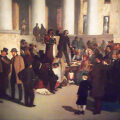By Renee S. Gordon
The presence of people of African descent in America really begins with the freemen who accompanied the Spanish explorers, the most notable of which was Estavanico. In 1585 privateer and slaver Francis Drake sailed to the colony of his distant cousin Sir Walter Raleigh, after pillaging a slave-trading colony in the Cape Verde Islands and other Spanish colonies including St. Augustine in Florida territory. The Roanoke, VA group was in desperate need of food and supplies and Drake was prevailed upon to return them to England. In order to make room some scholars theorize that he offloaded the majority of the 500 African and Indian slaves and records state that he returned to England with 100 Africans. It is believed that they mixed with the indigenous population and DNA testing is being done to answer the questions. www.virginia.org
Though Africans were brought to the New World, even English colonies, we date the earliest documented American colonial slavery as August 20, 1619 when “”twenty and odd Negroes, ” Angolan slaves, were brought into Hampton Bay aboard the White Lion, a Dutch ship accompanying an English pirate ship. The ship was in need of repair and it docked at Old Point Comfort where they disembarked at the dock of Abraham Piersey. The majority of the Africans were sold to Piersey and Governor Yeardley and taken by smaller boats to Jamestown. It must be noted that Jamestown’s March 1619 census listed 15 men and seven women indentures of African descent already residing in the colony. The significance of the 1619 arrival is both that these were the first slaves in an English colony and this event served as the genesis of slavery in the broader US and that they are the earliest blacks on these shores whose origins can be reliably traced.
A walk through African American history in Hampton is facilitated by a series of silver and black historic markers indicating the sites. There are more than 2,200 throughout the state and over 70 within the Greater Hampton area. Virginia has been marking sites of importance since 1927 and they have created a new series of markers for Hampton’s 400th anniversary. Text, maps and directions are available on the web. www.dhr.virginia.gov/index
Old Point Comfort was the location of the historically significant landing in 1619 and it would go on to become the site of Forts Algernourne and Monroe also of extreme historic consequence. The peninsular Point Comfort is situated on the Chesapeake Bay’s western shoreline. In 1607 settlers found this area of excellent anchorage after a long search and stated that the discovery gave them “good comfort.”
In 1609 a fort was constructed on the site to defend the colonists from the natives and raiders. It was named in honor of Lord Algernon Percie and 25 soldiers were billeted there. It burned in 1612 and was not replaced until the 1730s when Fort George was built. A hurricane destroyed Fort George in 1749.
Old Point Comfort Lighthouse, the oldest operating lighthouse on the bay, was erected in 1802 at a cost of $5000. The 54-foot structure is hand-cut stone with spiral stairs and a red copper roof. During the War of 1812 it was seized by the British and used as an observation tower. During the Civil War it escaped unscathed and it stands today as a witness to history and a Virginia National Landmark.
Because the British were able to invade Washington, DC in 1812 the government decided to build another fort to guard the entrance to the Chesapeake. Simon Bernard, a French engineer, was called upon to design the fortification and work began in 1819 and continued until 1834. Fort Monroe, named in honor of President Monroe, is an irregular moated hexagon with bastions, two-story Federal residences, a parade ground and 1.3-miles of walls on 63-acres of land. It remains the largest stone fort ever constructed and the 2nd oldest army installation in the nation. Enslaved people completed much of the construction and the 8-foot deep moat was dug by hand.
During the Civil War the fort was held by the Union as a supply depot and the battle of the ironclads, the Monitor and the Merrimac, took place in the water near the fort. By far the most momentous thing to occur there was the refusal of General Benjamin Butler to return three fugitive slaves owned by Colonel Charles K. Mallory. Butler, a Massachusetts lawyer, declared them “contraband of war” because their labor would be used to aid the war effort in the rebelling states if re-enslaved. In doing this he openly defied the Fugitive Slave Law of 1850, a stance the US Congress endorsed and later mandated as policy. Fort Monroe became a refuge for African Americans and was known as Freedom’s Fortress. Ironically, the site of the 1619 enslavement was also the location of the first freedom for some of their descendents.
The Casemate Museum, located inside the walls of the fort, was founded in 1951. A 19 site, 90-minute, walking tour includes museum galleries and outdoor displays. Highlights of the tour are, the cell in which Jefferson Davis was imprisoned, Butler’s mess chest from Tiffany’s, two original guns, dioramas and artifacts. Admission is free daily and ID is required. www.tradoc.army.mil/museum
On September 17, 1861 Mary Peake began teaching the people of the Grand Contraband Camp to read and write beneath a large oak tree near Fort Monroe in defiance of the law. It is believed to be the first organized effort of its kind. In 1863 beneath its boughs area residents attended the first reading in the South of Lincoln’s Emancipation Proclamation. Today the 98-foot in diameter Emancipation Oak stands on the campus of Hampton University, is a National Historic Landmark and “National Geographic” has designated it one of the “10 Great Trees of the World.” In May, after speaking at Hampton University, President Obama was given a sapling from the tree. It has been planted at the White House. www.hmdb.org
Union General Samuel Armstrong founded Hampton Normal and Agricultural Institute in 1868. In that same year he established Hampton Museum making it the oldest African American Museum in the nation. The modern collection consists of 9,500 objects, features the first compilation of African art by an African American and the first African American art collected by an institution. The artworks are stunning as is the building in which they are displayed. Numerous renowned artists are represented but the acknowledged highlight of a visit is Henry Ossawa Tanner’s “The Banjo Lesson.” Admission is free. www.hamptonu.edu/museum
IPod Experience Tours of the 255-acre Hampton University are offered and include six National Historic Sites and a 60-minute narrative within a 14-block area. Absolute must-sees are the Booker T. Washington Memorial Garden and Statue, Emancipation Oak and Memorial Chapel. The waterfront campus is beautiful and the history is unique. www.hamptonu.edu
Ocean Cottage Sunday School began in 1877, with three children from the African American community of Newton, in the home of George Row. When attendance increased a building was constructed on land known as Little England about 1879. It is believed that Hampton students, who also regularly taught there, built the chapel. Little England Chapel is Virginia’s only extant African American missionary chapel and was added to the National Register of Historic Places in 1982. It was restored in 1993. Tours include the original organ and other artifacts. Admission is free Tues.- Saturday. 757-722-5308
Hampton, Virginia has been at the forefront of history from our country’s origin. This year the city is celebrating its 400-year heritage and diversity with festivals and fireworks, special tours and sensational activities. Many of the events are free and all of them are family-oriented. It is not too late to join the party. Happy Birthday Hampton! www.visithampton.com
I wish you smooth and celebratory travels!
Travel Tip: Dr. Colita Nichols Fairfax has penned an informative book on the African American presence in Hampton. The book, “Hampton, Virginia,” is part of the Black America Series printed by Arcadia Publishing Co. Her book is a great way to learn about the destination and make the most of your trip. www.arcadiapublishing.com
















Leave a Comment